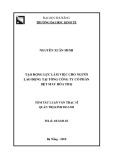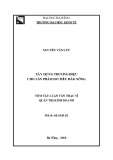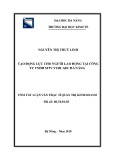
ROTHE TIME-DISCRETIZATION METHOD APPLIED
TO A QUASILINEAR WAVE EQUATION SUBJECT
TO INTEGRAL CONDITIONS
ABDELFATAH BOUZIANI AND NABIL MERAZGA
Received 27 January 2004 and in revised form 12 February 2004
This paper presents a well-posedness result for an initial-boundary value problem with
only integral conditions over the spatial domain for a one-dimensional quasilinear wave
equation. The solution and some of its properties are obtained by means of a suitable
application of the Rothe time-discretization method.
1. Introduction
Recently, the study of initial-boundary value problems for hyperbolic equations with
boundary integral conditions has received considerable attention. This kind of condi-
tions has many important applications. For instance, they appear in the case where a
direct measurement quantity is impossible; however, their mean values are known.
In this paper, we deal with a class of quasilinear hyperbolic equations (Tis a positive
constant):
∂2v
∂t2−∂2v
∂x2=fx,t,v,∂v
∂t ,(x,t)∈(0,1) ×[0,T], (1.1)
subject to the initial conditions
v(x,0)=v0(x), ∂v
∂t (x,0)=v1(x), 0 x1, (1.2)
and the boundary integral conditions
1
0v(x,t)dx =E(t), 0 tT,
1
0xv(x,t)dx =G(t), 0 tT,
(1.3)
where f, v0,v1,E,andGare sufficiently regular given functions.
Problems of this type were first introduced in [3], in which the first author proved the
well-posedness of certain linear hyperbolic equations with integral condition(s). Later,
Copyright ©2004 Hindawi Publishing Corporation
Advances in Difference Equations 2004:3 (2004) 211–235
2000 Mathematics Subject Classification: 35L05, 35D05, 35B45, 35B30
URL: http://dx.doi.org/10.1155/S1687183904401071

212 On a quasilinear wave equation with integral conditions
similar problems have been studied in [1,4,5,6,7,8,16,24,25] by using the energetic
method, the Schauder fixed point theorem, Galerkin method, and the theory of charac-
teristics. We refer the reader to [2,9,10,11,12,13,14,15,17,21,22,23,26] for other
types of equations with integral conditions.
Differently to these works, in the present paper, we employ the Rothe time-discre-
tization method to construct the solution. This method is a convenient tool for both the
theoretical and numerical analyses of the stated problem. Indeed, in addition to giving the
first step towards a fully discrete approximation scheme, it provides a constructive proof
of the existence of a unique solution. We remark that the application of Rothe method to
this nonlocal problem is made possible thanks to the use of the so-called Bouziani space,
first introduced by the first author, see, for instance, [4,6,20].
Introducing a new unknown function u(x,t)=v(x,t)−r(x,t), where
r(x,t)=62G(t)−E(t)x−23G(t)−2E(t), (1.4)
problem (1.1)–(1.3) with inhomogeneous integral conditions (1.3) can be equivalently
reduced to the problem of finding a function usatisfying
∂2u
∂t2−∂2u
∂x2=fx,t,u,∂u
∂t ,(x,t)∈(0,1) ×I, (1.5)
u(x,0)=U0(x), ∂u
∂t (x,0)=U1(x), 0 x1, (1.6)
1
0u(x,t)dx =0, t∈I, (1.7)
1
0xu(x,t)dx =0, t∈I, (1.8)
where
I:=[0,T],
fx,t,u,∂u
∂t :=fx,t,u+r,∂u
∂t +∂r
∂t −∂2r
∂t2,
U0(x):=v0(x)−r(x,0),
U1(x)=v1(x)−∂r
∂t (x,0).
(1.9)
Hence, instead of looking for v, we simply look for u. The solution of problem (1.1)–(1.3)
will be directly obtained by the relation v=u+r.
The paper is divided as follows. In Section 2, we present notations, definitions, as-
sumptions, and some auxiliary results. Moreover, the concept of the required solution is
stated, as well as the main result of the paper. Section 3 is devoted to the construction
of approximate solutions of problem (1.5)–(1.8) by solving the corresponding linearized
time-discretized problems, while in Section 4, some a priori estimates for the approxima-
tions are derived. We end the paper by Section 5 whereweprovetheconvergenceofthe
method and the well-posedness of the investigated problem.

A. Bouziani and N. Merazga 213
2. Preliminaries, notation, and main result
Let H2(0,1) be the (real) second-order Sobolev space on (0,1) with norm ·
H2(0,1) and
let (·,·)and· be the usual inner product and the corresponding norm, respectively,
in L2(0,1). The nature of the boundary conditions (1.7)and(1.8) suggests introducing
the following space:
V:=φ∈L2(0,1); 1
0φ(x)dx =1
0xφ(x)dx =0, (2.1)
which is clearly a Hilbert space for (·,·).
Our analysis requires the use of the so-called Bouziani space B1
2(0,1) (see, e.g., [4,5])
defined as the completion of the space C0(0,1) of real continuous functions with compact
support in (0,1), for the inner product
(u,v)B1
2=1
0
ℑxu·ℑ
xvdx (2.2)
and the associated norm
vB1
2=(v,v)B1
2, (2.3)
where ℑxv:=x
0v(ξ)dξ for every fixed x∈(0,1). We recall that, for every v∈L2(0,1), the
inequality
v2
B1
2
1
2v2(2.4)
holds, implying the continuity of the embedding L2(0,1) ֓B1
2(0,1).
Moreover, we will work in the standard functional spaces of the types C(I,X),
C0,1(I,X), L2(I,X), and L∞(I,X), where Xis a Banach space, the main properties of which
can be found in [19].
For a given function w(x,t), the notation w(t) is automatically used for the same func-
tion considered as an abstract function of the variable t∈Iinto some functional space
on (0,1). Strong or weak convergence is denoted by →or ⇀, respectively.
The Gronwall lemma in the following continuous and discrete forms will be very use-
ful to us thereafter.
Lemma 2.1. (i) Let x(t)0,andleth(t),y(t)be real integrable functions on the interval
[a,b].If
y(t)h(t)+t
ax(τ)y(τ)dτ,∀t∈[a,b], (2.5)
then
y(t)h(t)+t
ah(τ)x(τ)expt
τx(s)dsdτ,∀t∈[a,b].(2.6)

214 On a quasilinear wave equation with integral conditions
In particular, if x(τ)≡Cis a constant and h(τ)is nondecreasing, then
y(t)h(t)eC(t−a),∀t∈[a,b].(2.7)
(ii) Let {ai}be a sequence of real nonnegative numbers satisfying
aia+bh
i
k=1
ak,∀i=1,..., (2.8)
where a,b,andhare positive constants with h<1/b. Then
aia
1−bh expb(i−1)h
1−bh ,∀i=1,2,.... (2.9)
Proof. Theproofisthesameasthatof[18, Lemma 1.3.19].
Throughout the paper, we will make the following assumptions:
(H1)f(t,w,p)∈L2(0,1) for each (t,w,p)∈I×V×Vand the following Lipschitz
condition:
f(t,w,p)−f(t′,w′,p′)
B1
2l|t−t′|+w−w′B1
2+p−p′B1
2(2.10)
is satisfied for all t,t′∈Iand all w,w′,p,p′∈V, for some positive constant l;
(H2)U0,U1∈H2(0,1);
(H3) the compatibility condition U0,U1∈V, that is, concretely,
1
0U0(x)dx =1
0xU0(x)dx =0, (2.11)
1
0U1(x)dx =1
0xU1(x)dx =0.(2.12)
We look for a weak solution in the following sense.
Definition 2.2. A weak solution of problem (1.5)–(1.8) means a function u:I→L2(0, 1)
such that
(i) u∈C0,1(I,V);
(ii) uhas (a.e. in I) strong derivatives du/dt ∈L∞(I,V)∩C0,1(I,B1
2(0,1)) and
d2u/dt2∈L∞(I,B1
2(0,1));
(iii) u(0) =U0in Vand (du/dt)(0) =U1in B1
2(0,1);
(iv) the identity
d2u
dt2(t),φB1
2
+u(t),φ=ft,u(t), du
dt (t),φB1
2
(2.13)
holds for all φ∈Vand a.e. t∈I.

A. Bouziani and N. Merazga 215
Note that since u∈C0,1(I,V)anddu/dt ∈C0,1(I,B1
2(0,1)), condition (iii) makes sense,
whereas assumption (H1), together with (i) and the fact that du/dt ∈L∞(I,V)and
d2u/dt2∈L∞(I,B1
2(0,1)), implies that (2.13) is well defined. On the other hand, the ful-
fillment of the integral conditions (1.7)and(1.8)isincludedinthefactthatu(t)∈V,for
all t∈I.
The main result of the present paper reads as follows.
Theorem 2.3. Under assumptions (H1), (H2), and (H3), problem (1.5)–(1.8)admitsa
unique weak solution u, in the sense of Definition 2.2, that depends continuously upon the
data f,U0,andU1. Moreover, the following convergence statements hold:
un−→ uin C(I,V), with convergence order O1
n1/2,
δun−→ du
dt in CI,B1
2(0,1),
d
dtδun⇀d2u
dt2in L2I,B1
2(0,1),
(2.14)
as n→∞, where the sequences {un}nand {δun}nare defined in (3.18)and(3.19), respectively.
3. Construction of an approximate solution
Let nbe an arbitrary positive integer, and let {tj}n
j=1be the uniform partition of I,tj=jhn
with hn=T/n. Successively, for j=1,...,n, we solve the linear stationary boundary value
problem
uj−2uj−1+uj−2
h2
n
−d2uj
dx2=fj,x∈(0,1), (3.1)
1
0uj(x)dx =0, (3.2)
1
0xuj(x)dx =0, (3.3)
where
fj:=ftj,uj−1,uj−1−uj−2
hn, (3.4)
starting from
u−1(x)=U0(x)−hnU1(x), u0(x)=U0(x), x∈(0,1).(3.5)
Lemma 3.1. For each n∈N∗and each j=1,...,n,problem(
3.1)j–(3.3)jadmits a unique
solution uj∈H2(0,1).
Proof. We use induction on j. For this, suppose that uj−1and uj−2are already known
and that they belong to H2(0,1), then fj∈L2(0, 1). From the classical theory of linear
ordinary differential equations with constant coefficients, the general solution of (3.1)j








![Hình ảnh học bệnh não mạch máu nhỏ: Báo cáo [Năm]](https://cdn.tailieu.vn/images/document/thumbnail/2024/20240705/sanhobien01/135x160/1985290001.jpg)

















